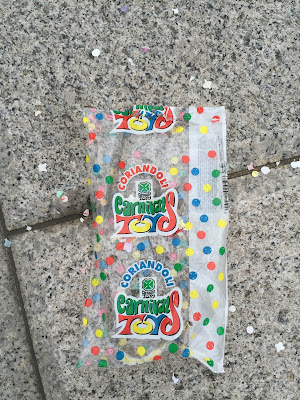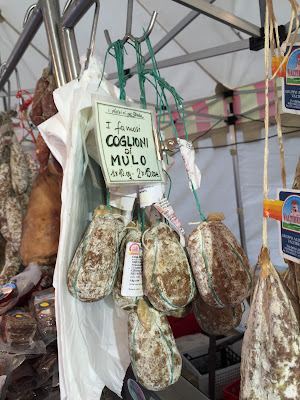previous lesson | this lesson | next lesson
coriandoli – “confetti”
For days we kept wondering why there were little pieces of paper in the street. Finally, it became head-slapping obvious: it’s carnevale, the feast before Lent. Families buy bags of confetti, coriandoli, and celebrate in the piazze by throwing it into the air explaining why we kept seeing it in the street. Corandolo happens to also be the word for coriander (Coriandrum sativum), which led to some confusion initially when people tried to explain carneval to us. We keep imagining people throwing coriander seeds. However, according to Trecanni.it, coriandolo also refers to confections topped with coriander seeds, and by extension, confetti that resembles the confection. So we weren’t too far off.



coglioni di mulo – “mule balls”
During carnevale, vendor stalls or bancarelle spring up along the Il Sentierone in Bergamo. One of them was selling products from Norcia in Umbria. Palle di nonno or “grandpa’s balls” and coglioni di mulo are typical of the Norcia area. The common names refer to their shape. They taste good.

chiave da accordare – “tuning key”
The verb accordare means to tune, in the musical sense. And, a chiave is a key. We saw this description in the Museo donizettiano in the Città Alta. Gaetano Donizetti is a famous Italian composer who was born and raised in Bergamo. If I read the sign at the museum correctly, he lived in the building that now houses the museum.

polenteria – “place of polenta”
Polentone serves take-away polenta. Polenta is very common in this part of Italy, appearing on almost every menu you'll see. “eria” is used commonly in shop titles, like erboristeria, pasticceria, pizzeria, and tabaccheria. Eria is equivalent to ery in English, and usually means the trade or craft of an object or service or a place you can get that object or service.

polentine mignon – “miniature polentas”
Confections called polenta e osei are a common sight around Bergamo. They look like a small mound of polenta with a decoration on top. The ones we tried at La Marianna in Borgo S. Caterina were very sweet. Osei comes from oṡèi, a Venetian word meaning birds. It turns out that the confections resemble the traditional dish polenta e osei of Venezia, Brescia and Bergamo, which consists of a mound of polenta with cooked birds on top. Birds as in the kind that might be flying about the yard like sparrows. (I heard that this dish is not legal to serve anymore.) After learning about the connection between the confections and the more macabre savory dish, I could easy see the little birds in the sweet versions as shown in these examples photographed at Il Fornaio and Nessi in Città Alta.



l’arte in un espresso – “the art in an espresso”
This phrase is a flyer for the Bugan Coffee Lab, one of the places in Bergamo (that we’ve discovered so far) that stands out in terms of coffee. The Coffee Lab is serious about coffee and it is always a pleasure to drop by. Other spots for coffee we recommend are L’Arte Caffè and La Chicca. These three places satisfy our afternoon coffee indulgences. We take our morning coffee without fail at Caffè Papavero, because it’s good coffee, fun company, and in our neighborhood, so we can catch up the news of the day.

io sono la porta – “I am the gate”
Reminds me of the current exhibition running in Bergamo, Io sono il sarto – “I am the tailor,” which deals with the work of the artist Giovanni Battista Moroni, the 15th century artist who created penetrating portraits of people from Bergamo. The title of the exhibition takes its name from one of his best known paintings, Il Sarto. Io sono la porta is a quote from the bible, John 10. This gate or door is on the side of the Basilica di Santa Maria Maggiore.

in questa piazzetta è vietato qualsiasi rumore molesto – “No loud noises in this (small) piazza”
This sign is in the piazzetta Manzù at the entrance of the charming Osteria al Vecchio Tagliere. In the piazzetta, there is a large mural ‘Busto di Ingo’ allo specchio inspired by the Giacomo Manzù sculpture ‘Busto di Inge’. The mural depicts Inge, Manzù’s wife, reaching her arms up over her head, threatening noise makers. Manzù was born in one of the houses surrounding the piazzetta.


No comments:
Post a Comment
All comments are moderated. If your comment doesn't appear right away, it was likely accepted. Check back in a day if you asked a question.